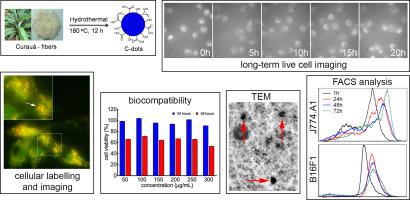Biomaterials Advances ( IF 7.9 ) Pub Date : 2021-09-02 , DOI: 10.1016/j.msec.2021.112409 Sebastian Raja 1 , Eva Miriam Buhl 2 , Stephan Dreschers 3 , Carmen Schalla 4 , Martin Zenke 4 , Antonio Sechi 4 , Luiz H C Mattoso 5

|
This study reports the generation of curauá-derived carbon dots (C-dots) and their suitability for Fe(III) detection, bioimaging and FACS analysis. C-dots were generated from curauá (Ananas erectifolius) fibers by a facile one-step hydrothermal approach. They exhibited graphite-like structure with a mean diameter of 2.4 nm, high water solubility, high levels of carboxyl and hydroxyl functional groups, excitation-dependent multicolor fluorescence emission (in the range 450 nm - 560 nm) and superior photostability. C-dots were highly selective and effective for the detection of ferric Fe(III) ion in an aqueous medium with a detection limit of 0.77 μM in the linear range of 0–30 μM, a value much lower than the guideline limits proposed by the World Health Organization (WHO). In biological cell systems, C-dots were very well tolerated by B16F1 mouse melanoma and J774.A1 mouse macrophages cell lines, both of which effectively internalized C-dots in their cytoplasmic compartment. Finally, C-dots were effective probes for long-term live cell imaging experiments and multi-channel flow cytometry analysis. Collectively, our findings demonstrate that curauá-derived C-dots serve as versatile and effective natural products for Fe(III) ion sensing, labeling and bioimaging of various cell types. This study adds novel C-dots to the library of carbon-based probes and paves the way towards a sustainable conversion of a most abundant biomass waste into value-added products.
中文翻译:

Curauá 衍生的碳点:用于有效 Fe(III) 离子检测、细胞标记和生物成像的荧光探针
本研究报告了库拉阿衍生碳点 (C-dots) 的产生及其对 Fe(III) 检测、生物成像和 FACS 分析的适用性。C-dots 是由 curauá (Ananas standifolius) 产生的纤维通过简单的一步水热方法。它们表现出平均直径为 2.4 nm 的类石墨结构、高水溶性、高水平的羧基和羟基官能团、依赖于激发的多色荧光发射(在 450 nm - 560 nm 范围内)和优异的光稳定性。C-dots 对检测水性介质中的 Fe(III) 离子具有高度选择性和有效性,在 0-30 μM 的线性范围内的检测限为 0.77 μM,该值远低于世界卫生组织 (WHO)。在生物细胞系统中,B16F1 小鼠黑色素瘤和 J774.A1 小鼠巨噬细胞系对 C 点的耐受性非常好,两者都有效地将 C 点内化到了它们的细胞质区室中。最后,C 点是长期活细胞成像实验和多通道流式细胞术分析的有效探针。总的来说,我们的研究结果表明,curauá 衍生的 C 点可作为多种有效的天然产物,用于 Fe(III) 离子传感、标记和各种细胞类型的生物成像。这项研究为碳基探针库添加了新的 C 点,并为将最丰富的生物质废物可持续转化为增值产品铺平了道路。



























 京公网安备 11010802027423号
京公网安备 11010802027423号